 In February and March, skunks go a-courting. But admiration isn’t always mutual, so a female may decide to send off an overly aggressive male with a shot of her perfume; hence, the sudden burst of scent seeping into the house on a late winter night.
In February and March, skunks go a-courting. But admiration isn’t always mutual, so a female may decide to send off an overly aggressive male with a shot of her perfume; hence, the sudden burst of scent seeping into the house on a late winter night.Profiles of notable Ridgefield, Connecticut, people of the past, along with musings on nature in suburbia and meanderings into The Old Days.
Follow us on Facebook's "Old Ridgefield" group or at www.RidgefieldHistory.com
Thursday, February 27, 2014
Good scents
 In February and March, skunks go a-courting. But admiration isn’t always mutual, so a female may decide to send off an overly aggressive male with a shot of her perfume; hence, the sudden burst of scent seeping into the house on a late winter night.
In February and March, skunks go a-courting. But admiration isn’t always mutual, so a female may decide to send off an overly aggressive male with a shot of her perfume; hence, the sudden burst of scent seeping into the house on a late winter night.Wednesday, July 09, 2008
Mousetrap in a tree
 More likely, though, the gray fox would have slipped far away before you were anywhere near being seen by him. He would not have been pressed to run up a tree – a feat he can easily accomplish, unique among North American canines.
More likely, though, the gray fox would have slipped far away before you were anywhere near being seen by him. He would not have been pressed to run up a tree – a feat he can easily accomplish, unique among North American canines.
No, the fox would have heard you coming from a long distance off. Sensitive ears, able to detect a mouse squeak at 300 feet, help make him a valuable pest-control device. Vermin like rats and mice are among its favorite foods and, as disease and tick carriers, one of our least favorite visitors.
Early in the morning, in the pre-dawn light, you may spot the long, low form of a gray fox winding around your lawn, ears up, nose down, a four-footed mousetrap.
Wednesday, January 16, 2008
Tunnel time
 If the snow is not too deep or if it is melting, you may also spot narrow tunnels that curve, loop and zigzag under the crust and near the ground. They are a sign that shrews have been foraging for overwintering insect eggs and grubs. Tiny and weighing a fraction of an ounce, shrews are the hummingbirds of the mammal world. They live a high-speed existence, with a heart that beats up to 1,200 times per minute - 20 beats per second! To keep that machine going, shrews must eat up to three times their weight each day.
If the snow is not too deep or if it is melting, you may also spot narrow tunnels that curve, loop and zigzag under the crust and near the ground. They are a sign that shrews have been foraging for overwintering insect eggs and grubs. Tiny and weighing a fraction of an ounce, shrews are the hummingbirds of the mammal world. They live a high-speed existence, with a heart that beats up to 1,200 times per minute - 20 beats per second! To keep that machine going, shrews must eat up to three times their weight each day.
No wonder they wander in all weather. But unlike commuting humans, shrews probably like traveling in the snow. It helps hide their movements and sounds from the sharp eyes and ears of nocturnal predators like owls and foxes who might love a juicy shrew for a midnight snack.
Wednesday, December 05, 2007
The nose knows
 Cats rub against people and places to deposit saliva and secretions from three glands on the head. These deposits send a message to other cats: You are part of their territory. It may be like posting a “no trespassing” sign.
Cats rub against people and places to deposit saliva and secretions from three glands on the head. These deposits send a message to other cats: You are part of their territory. It may be like posting a “no trespassing” sign.
In the wild, creatures from lowly mice to lumbering bears and fleet-footed deer mark the trees and ground with semiochemicals. “Semio” is from Greek, meaning a “sign,” and mammalian signs are read with considerable interest. They often define territories, but their particular mixture of 50 or more compounds may even identify an individual animal, as a name or Social Security number identifies us.
In the case of deer, the meaning of scents can be quite complex, advertising a buck’s status in the herd, triggering the reproductive cycle in females and perhaps even stemming the sexual drive in bucks of lower status.
Most mammals have much better olfaction than humans – dogs and their wild kin have up to a million times more scent receptors than we do.
So remember when you take Fido for a walk: Those leaves and twigs he spends so much time sniffing could be his version of reading the local newspaper.
Tuesday, November 13, 2007
Gliding through the night
 Both the Northern and Southern Flying Squirrels are mini versions of their daytime cousins – about half the size of a Gray Squirrel. Big-eyed because they are nocturnal, they make use of a flap of furry skin to glide – not fly – a hundred feet or more. They eat the usual squirrel foods, like nuts, seeds, insects and eggs, though the Northern is said to have a fondness for truffles and other tasty fungi.
Both the Northern and Southern Flying Squirrels are mini versions of their daytime cousins – about half the size of a Gray Squirrel. Big-eyed because they are nocturnal, they make use of a flap of furry skin to glide – not fly – a hundred feet or more. They eat the usual squirrel foods, like nuts, seeds, insects and eggs, though the Northern is said to have a fondness for truffles and other tasty fungi.
Flying squirrels were once much better known and appreciated, not as aeronautical wizards but as companions. As far back as colonial times, people caught them as babies and raised them as pets. One of John Singleton Copley’s most famous paintings, “Boy with A Squirrel,” shows Copley’s half brother seated at a desk with a pet flying squirrel alongside him.
All is not perfect in this man-rodent relationship, however, and flying squirrels will sometimes infest attics. A dozen or more might decide to spend the winter huddled together in the comfort of your home.
Wednesday, September 26, 2007
Nut birds
 Not necessarily. Biologist M.R. Chettleburgh has found that during the single month of October, 30 to 40 jays can gather and plant more than 20,000 acorns alone. The jays are caching them for future use, but often forget their whereabouts, allowing the nuts to sprout.
Not necessarily. Biologist M.R. Chettleburgh has found that during the single month of October, 30 to 40 jays can gather and plant more than 20,000 acorns alone. The jays are caching them for future use, but often forget their whereabouts, allowing the nuts to sprout.
On average, jays carry these acorns a quarter mile from the tree that bore them, but often they fly them a half to three-quarters of a mile away. No lazy, old squirrel is going to haul an acorn a half-mile.
Clearly, jays are the real planters and spreaders of our woodlands. In Siberia, in fact, they are protected by the state because of their forest-expanding abilities.
And maybe that's why Blue Jays are so noisy at this time of year, screeching and squawking seemingly from dawn to dusk: They're whining about all the credit the squirrels get for being hard-working.
Wednesday, September 19, 2007
Beeches and bears
 For a bear, however, a real beech nut is like candy.
For a bear, however, a real beech nut is like candy.
At this time of year, Black Bears will climb 60 or more feet to the top of an American Beech to search for its offering of food. The bear will break off nut-laden branches from the tree’s crown and stuff in them in the crotches of limbs while it picks off and eats the nuts. Old New Englanders called the resulting tangles of nutless, broken branches “bear nests.”
Why go through all this trouble when berries and other foods abound down below? The beech nut is said to be the calorically richest nut in North America, containing at least 50% fat and 20% protein. For a bear about to hunker down for a long winter’s nap, that’s an ideal food – well worth the climb and the work that includes breaking off branches up to two and a half inches in diameter.
Wednesday, May 02, 2007
Killer cats
 Few scenes are as peaceful and domestic as the family cat, curled up and purring in your lap, on a cool spring evening. But for uncountable millions of creatures, house cats are not so warm and fuzzy, and feline fangs are the last thing they see before they die.
Few scenes are as peaceful and domestic as the family cat, curled up and purring in your lap, on a cool spring evening. But for uncountable millions of creatures, house cats are not so warm and fuzzy, and feline fangs are the last thing they see before they die.Conservation officials say that of the 90 million pet cats in the U.S., only 35% are kept indoors. The rest are let loose to hunt, killing “hundreds of millions of birds, and more than a billion small mammals, such as rabbits, squirrels, and chipmunks each year,” says the Connecticut Department of Environmental Protection.
Habitat destruction is the leading cause of declining bird populations, but right up in second place are cats, both domestic and feral.
The killer is becoming the killed, however, as house cats are now prey themselves. Increasing numbers of coyotes and now fishers – a large carnivorous marten that has been reintroduced into our woods – are catching and eating many house cats.
The answer to both deadly problems is simple: Keep kitty indoors.
Friday, February 16, 2007
Fisher food
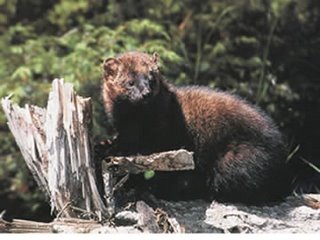 Their appearance is no accident. In 1988, the Connecticut Department of Environmental Protection bought a bunch of live-trapped fishers from upper New England, and released them in western Connecticut. The aim was to restore an animal that had once been native to the state, but had been driven away by the agricultural deforestation and perhaps overtrapping. Today, fishers are found throughout the state and are doing so well, licensed trapping is allowed in the fall.
Their appearance is no accident. In 1988, the Connecticut Department of Environmental Protection bought a bunch of live-trapped fishers from upper New England, and released them in western Connecticut. The aim was to restore an animal that had once been native to the state, but had been driven away by the agricultural deforestation and perhaps overtrapping. Today, fishers are found throughout the state and are doing so well, licensed trapping is allowed in the fall.
While fishers don’t fish – or even eat fish, they do love a tasty porcupine. That thorny fare is in rather short supply, however, so they have turned to a more abundant mammal for food: The squirrel.
In fact, in northern Vermont and New Hampshire, where the fisher was never extirpated, squirrels are much less common than they are here. The natives say it’s because the fishers keep them under control – good news for anyone who’s ever had squirrels invade their home.
Tuesday, January 09, 2007
Bunny blues
The only native rabbit in southern Connecticut, the New England Cottontail was once widespread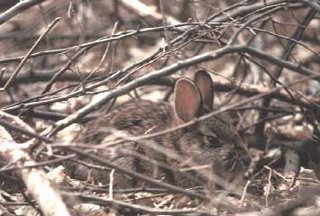 from southeastern New York to Maine. Today, studies by Connecticut and New Hampshire biologists are finding so few that this bunny has become a candidate for the federal Endangered Species List.
from southeastern New York to Maine. Today, studies by Connecticut and New Hampshire biologists are finding so few that this bunny has become a candidate for the federal Endangered Species List.
Several forces are working against the New England Cottontail. The thickets it lives in are disappearing, thanks to both man-made and natural changes. Its food is being gobbled up by deer and by the alien Eastern Cottontail, the rabbit we see all the time. Introduced a century ago by hunters seeking new game, the Eastern Cottontail is more adaptable to suburbanization.
There’s also the growing number of hawks, owls, coyotes, foxes, and even fishers, for whom rabbit is fine fare.
If all that isn’t bad enough, the New England Cottontail suffers from an identity crisis. It looks so much like an Eastern Cottontail that DNA samples are often needed to confirm that it’s native, not alien.
So even if you see one close-up, it’s tough to tell the rabbit is rare.
Tuesday, December 12, 2006
They’re coming…
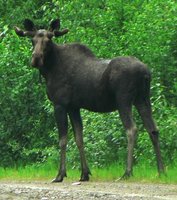 Now come warnings that moose on the move, extending their territory well into Connecticut and southeastern New York. And the difference between a moose and a deer is like the difference between a Doberman and a Chihuahua.
Now come warnings that moose on the move, extending their territory well into Connecticut and southeastern New York. And the difference between a moose and a deer is like the difference between a Doberman and a Chihuahua.
In September, a car struck and killed a 700-pound bull moose at Barkhamstead in upstate Connecticut. A month early, a crash killed a 500-pound moose in Goshen. These weren’t even “big” ones – moose can reach 1,100 pounds.
Connecticut wildlife experts estimate more than 100 moose are now in the state and their numbers are growing as their range extends southward toward metropolitan New York City.
What’s a motorist to do? The best advice is: Slow down! Be it deer or moose, or maybe even a 400-pound bear, the slower you’re going, the less the impact. You may even be able to avoid an impact altogether.
Tuesday, October 17, 2006
Fishing for cats
 A case in point is the fisher. This 10- to 15-pound marten has long been found in northern New England and forested regions across North America. But until a few years ago, these weasel-like mammals were unknown here. Now that the trees are back, so are the fishers.
A case in point is the fisher. This 10- to 15-pound marten has long been found in northern New England and forested regions across North America. But until a few years ago, these weasel-like mammals were unknown here. Now that the trees are back, so are the fishers.
Sometimes called fisher cats, fishers neither fish nor are they even closely related to cats. In fact, they may be a cat’s worst enemy. Fishers usually feed on wild mammals ranging from mice and voles to porcupines and young deer. In suburbia, however, domestic cats are becoming a fisher delicacy. And there’s little a hapless cat can do – run up a tree and the arboreal fisher will follow right behind.
It’s another good reason why all pet cats should be house cats.
Tuesday, September 19, 2006
Bounty from above
Oaks occasionally generate bountiful acorn crops – and many 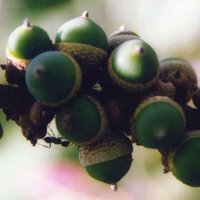 years, produce not a nut. Last spring apparently offered ideal conditions for pollinating oak flowers – dry, warm weather.
years, produce not a nut. Last spring apparently offered ideal conditions for pollinating oak flowers – dry, warm weather.
Of course, most of this year’s bumper crop will be consumed – by nearly 100 kinds of birds and mammals. For creatures as small as a nuthatch or a mouse and as large as a bear and a deer, acorns are a major source of food in the fall. The ebb and flow of populations of such common creatures as Gray Squirrels and Blue Jays are closely related to acorn yields.
With so many fans in nature, you’d think humans would be acorn-eaters, too. In fact, they once were: American Indians and early settlers ate acorns. Today, however, we’ve been spoiled by the sweeter meats of peanuts, cashews, almonds, and other nuts that are also easier to process – and to salt.
Tuesday, August 29, 2006
The embattled beaver
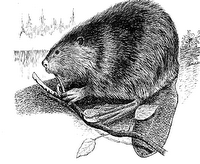 Pity the poor beaver. Although touted in countless film documentaries, the beaver’s industriousness is always getting the rodent into trouble.
Pity the poor beaver. Although touted in countless film documentaries, the beaver’s industriousness is always getting the rodent into trouble.To establish ponded homesteads, beavers kill trees to build dams. The dams often flood roads, lawns, septic systems, parking lots, basements, and other trappings of suburbia, angering the human neighbors.
It wasn’t always so. Driven from much of the East Coast by farmers who chopped down most of the trees, beavers had vanished in many areas by the 19th Century. With the return of woodlands in the 20th Century, various reintroduction efforts were successful – so successful in Connecticut that some 8,000 beaver live in that small state today.
Adult beavers have no natural enemies – except man. They are among the few creatures legally hunted with what are called “kill traps.” Amazingly, kill traps are the only legal way to catch them in Connecticut; it is illegal to live trap a beaver to relocate it. The official state explanation: There are so many beavers in Connecticut that moving them would only exacerbate problems elsewhere.
Being industrious and a movie star doesn’t always pay.
Saturday, March 11, 2006
Squirrel sweets
 For unknown centuries humans have harvested this spring treat. But they weren't the first.
For unknown centuries humans have harvested this spring treat. But they weren't the first.
Since long before men rammed spiles into sugar maple bark, Red Squirrels have been making pre-spring rounds of these trees. They nip the bark, creating little grooves to start the sap dripping, and then move on to bite more bark. A day or two later, after the sap that flowed from the cuts has mostly evaporated, the rodents return to eat the sweet, sticky residue.
How do they know this cause-and-effect connection -- that a bite plus a wait yields food? The sap has barely any taste, yet these animals have learned to distill the watery fluid to its sweet essence -- squirrel-made maple syrup.
Tuesday, February 14, 2006
Hard times for squirrels
 Gray squirrels often have it tough. Back in 2004, the acorn crop crashed, and the squirrels had a hard time surviving last winter. Those that did were often weak and more susceptible to predators – including the automobile tire. They produced smaller families, and their population declined markedly.
Gray squirrels often have it tough. Back in 2004, the acorn crop crashed, and the squirrels had a hard time surviving last winter. Those that did were often weak and more susceptible to predators – including the automobile tire. They produced smaller families, and their population declined markedly.
The 2005 acorn crop was reportedly a bit better, and until now, the winter of 2005-06 has been mild, so nature may be giving the Gray Squirrel a break.
That may not please folks who battle “tree rats” at the bird feeder or in their attics, but a healthy squirrel population helps keep forests healthy by planting oaks, hickories and other nut-bearing trees. Squirrels also provide food for hawks and owls, and, when they don’t cross at the green, for vultures and crows.
Monday, September 26, 2005
Look up
The squirrels haven't really disappeared. It is harvest season and, hidden in the leaves of oaks, beeches and hickories, squirrels are overhead, gathering ripe nuts fresh off the branch. Yes, they consider your birdfeeder a second-rate source of food. Fresh nuts will always win out.
 The puzzlement over the “lack” of squirrels points out a failing many of us have as backyard naturalists. We don't look up.
The puzzlement over the “lack” of squirrels points out a failing many of us have as backyard naturalists. We don't look up.
Dozens of creatures stare down at us as we go for walks, but we rarely see them because our eyes are turned to the ground. Look up and you may see a raccoon mother leading her babies along a limb, a flock of wild turkeys sunning themselves, or an owl eyeing dinner. Look up and you may see a Sharp-shinned Hawk in hot pursuit of a blackbird or a pack of crows mobbing a fleeing Great Horned Owl.
Not only life, but adventure can be found overhead.
The Jeremiah Bennett Clan: T he Days of the Desperados One morning in 1876, a Ridgefield man was sitting in a dining room of a Philadelphi...

-
T he Bradford pear is a “street tree” that’s blessed with benefits and cursed with shortcomings. A cultivar of an Asian tree, the Bradford...
-
Charles Bluhdorn: The 'Mad Austrian' His death seemed like his life: face-paced and high-powered. Charles G. Bluhdorn, who b...
-
Consuelo Vanderbilt Earl: A Last Link In her long life, Consuelo Vanderbilt Earl had many claims to fame, both locally and nationally....


